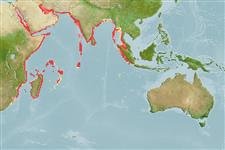>
Eupercaria/misc (Various families in series Eupercaria) >
Nemipteridae (Threadfin breams, Whiptail breams)
Etymology: Nemipterus: Greek, nema, -atos = filament + Greek, pteron = wing, fin (Ref. 45335).
More on author: Valenciennes.
Environment: milieu / climate zone / depth range / distribution range
Ecología
marino demersal; no migratorio; rango de profundidad 18 - 100 m (Ref. 30573). Tropical; 31°N - 30°S, 31°E - 103°E (Ref. 3810)
Indian Ocean: Red Sea, Persian Gulf, east Africa south to Delagoa Bay in Mozambique, Mauritius, Seychelles, Madagascar, Arabian Sea, Sri Lanka, Bay of Bengal, Andaman Sea, and Strait of Malacca. This species has generally been reported under the name Nemipteus delagoae or Nemipterus bleekeri.
Tamaño / Peso / Age
Maturity: Lm ? range ? - ? cm
Max length : 30.0 cm TL macho / no sexado; (Ref. 30573); common length : 25.0 cm TL macho / no sexado; (Ref. 5450)
Espinas dorsales (total): 10; Radios blandos dorsales (total): 9; Espinas anales 3; Radios blandos anales: 7. Suborbital spine absent. Preopercle with 3 transverse scale rows. Pectoral fins moderately long, reaching to or just behind anus. Pelvic fins long, reaching to or just beyond level of origin of anal fin. A line drawn up from posterior edge of suborbital reaching the dorsal profile about 3 to 5 scales before origin of dorsal fin. Scale rows on body below lateral line upward-curved anteriorly. Axillary scale present. Color: Upper body pinkish, silvery below. Snout with 2 indistinct stripes.
Found on sand or mud bottoms (Ref. 30573). Feeds mainly on crustaceans, cephalopods (Loligo), small fishes and polychaetes.
Life cycle and mating behavior
Madurez | Reproducción | Puesta | Huevos | Fecundidad | Larva
Russell, B.C., 1990. FAO Species Catalogue. Vol. 12. Nemipterid fishes of the world. (Threadfin breams, whiptail breams, monocle breams, dwarf monocle breams, and coral breams). Family Nemipteridae. An annotated and illustrated catalogue of nemipterid species known to date. FAO Fish. Synop. 125(12):149p. Rome: FAO. (Ref. 3810)
IUCN Red List Status (Ref. 130435)
Threat to humans
Harmless
Human uses
Pesquerías: escaso valor comercial
Más información
ReferenciasAcuiculturaPerfil de acuiculturaRazasGenéticaElectrophoresesheritabilidadEnfermedadesProcesamientoNutrientsMass conversion
ColaboradoresImágenesStamps, Coins Misc.SonidosCiguateraVelocidadTipo de nataciónSuperficie branquialOtolitosCerebrosVisión
Herramientas
Special reports
Download XML
Fuentes de Internet
Estimates based on models
Preferred temperature (Ref.
123201): 22.8 - 28.7, mean 26.1 °C (based on 168 cells).
Phylogenetic diversity index (Ref.
82804): PD
50 = 0.5000 [Uniqueness, from 0.5 = low to 2.0 = high].
Bayesian length-weight: a=0.01259 (0.01037 - 0.01528), b=2.96 (2.92 - 3.00), in cm total length, based on LWR estimates for this species (Ref.
93245).
Nivel trófico (Ref.
69278): 3.9 ±0.49 se; based on food items.
Resiliencia (Ref.
120179): Alto, población duplicada en un tiempo mínimo inferior a 15 meses (K=0.4-0.8).
Fishing Vulnerability (Ref.
59153): Low to moderate vulnerability (28 of 100).
Nutrients (Ref.
124155): Calcium = 425 [97, 827] mg/100g; Iron = 1.2 [0.4, 3.4] mg/100g; Protein = 18.1 [16.4, 19.6] %; Omega3 = 0.283 [0.140, 0.611] g/100g; Selenium = 41.8 [17.2, 118.2] μg/100g; VitaminA = 9.74 [2.26, 53.89] μg/100g; Zinc = 0.768 [0.447, 2.573] mg/100g (wet weight); based on
nutrient studies.
